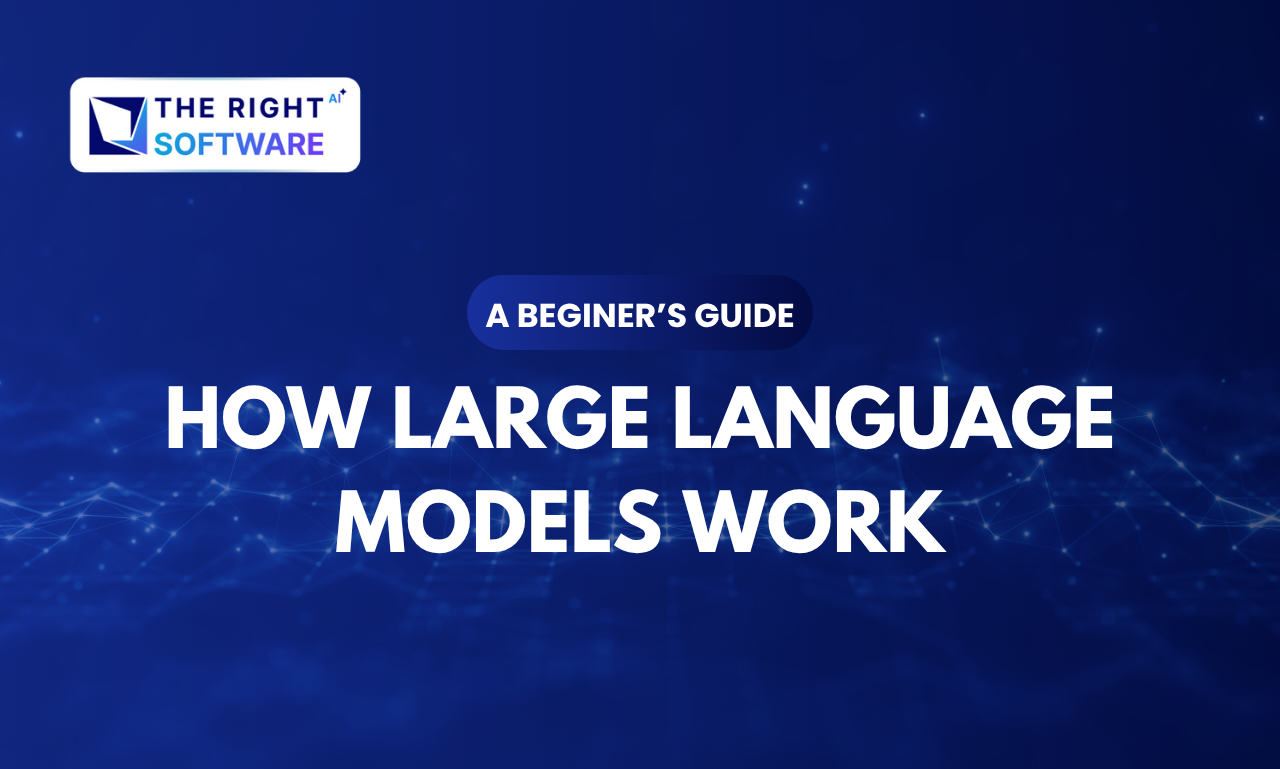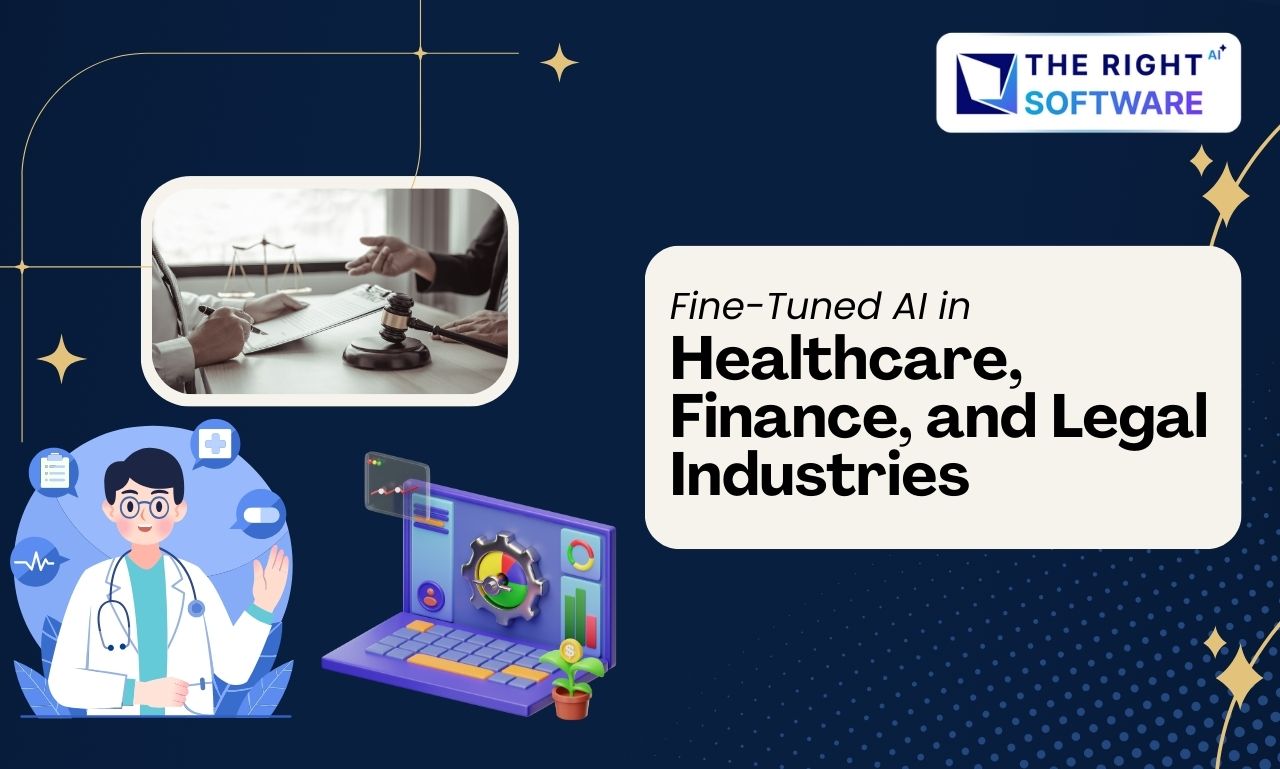Introduction: Making Sense of the AI Revolution
Artificial Intelligence is no longer a futuristic dream — it’s part of our daily lives. From voice assistants like Siri and Alexa to tools like ChatGPT, AI systems powered by Large Language Models (LLMs) are shaping how we communicate, learn, and work.
But what exactly are these models, and how do they understand and respond like humans?
This beginner’s guide from The Right Software breaks down the magic behind large language models in the simplest way possible. Whether you’re a developer curious about AI or a business owner exploring automation, you’ll get a clear picture of how LLMs function and what makes them so powerful.
Section 1: The Foundation of Large Language Models
At their core, large language models are trained systems that predict text — word by word, sentence by sentence. To do this, they rely on three fundamental elements: data, tokens, and training.
1. Data: The Fuel That Powers AI
Every LLM begins with data — massive amounts of it.
They are trained on billions of words from books, websites, research papers, code repositories, and conversations. This allows the model to observe patterns, sentence structures, and context.
Think of it like reading the entire internet. The more a model reads, the more it understands how people use language.
2. Tokens: The Building Blocks of Language
| Sentence | Tokens (Pieces of Text) |
|---|---|
| “The cat sat on the mat.” | The |
| “AI helps developers code faster.” | AI |
This process is called tokenization, and it allows the model to analyze and learn from even the smallest components of text.
LLMs don’t understand full sentences like humans. Instead, they break everything down into smaller pieces called tokens — which can be whole words, parts of words, or even characters.
For example:
“Artificial Intelligence” → “Artificial”, “Intelligence” (2 tokens)
“AI” → “A”, “I” (2 tokens)
By learning how tokens appear together, models start recognizing context and meaning.
3. Training: Learning from Patterns
Training is where the real learning happens.
During this phase, the model is fed a sequence of words (tokens) and asked to predict the next one. The more predictions it makes, the more accurate it becomes.
This is achieved through machine learning algorithms that fine-tune the model’s understanding. Over time, the model becomes capable of writing essays, code, poems, and even answering technical questions — all by predicting what’s most likely to come next.
Section 2: The Neural Networks Behind the Magic
So, how do these models actually “learn”? The answer lies in neural networks, specifically a type called Transformers — the architecture that powers today’s LLMs.
1. What Is a Neural Network?
A neural network is a system inspired by the human brain. It consists of layers of nodes (neurons) that process information. Each layer analyzes data, finds relationships, and passes refined results to the next layer.
In the context of LLMs, neural networks help the model understand the relationship between words and context.
2. The Transformer Architecture
Before Transformers, older models processed text sequentially — one word at a time — which was slow and limited.
| Feature | Traditional RNN Models | Transformer Models |
|---|---|---|
| Processing | Word-by-word (sequential) | All words at once (parallel) |
| Speed | Slower | Much faster |
| Context Handling | Struggles with long text | Understands long context easily |
| Training Data Size | Limited | Extremely large |
| Accuracy | Lower | Significantly higher |
Transformers revolutionized this by allowing models to process entire sentences or paragraphs at once using a mechanism called attention.
The “attention” mechanism helps the model decide which words matter most when interpreting meaning.
For example:
In the sentence, “The cat chased the mouse because it was hungry,” the model uses attention to figure out that “it” refers to “the cat” — not “the mouse.”
This attention-based structure allows Transformers to handle long, complex texts efficiently and accurately.
3. Training at Scale
Large language models like GPT or PaLM are trained on hundreds of billions of parameters — mathematical values that represent learned knowledge.
These parameters fine-tune how the model interprets tone, grammar, logic, and emotion.
The larger the number of parameters, the more nuanced and human-like the responses.
Section 3: How Large Language Models Generate Responses
Once an LLM is trained, how does it actually generate a reply when you type something?
1. Input Understanding
When you enter a prompt — for example, “Write me a poem about summer” — the model first breaks it into tokens. It analyzes these tokens to understand intent, tone, and context.
It’s not reading like a human, but rather statistically analyzing what each word likely represents based on its training data.
2. Prediction and Probability
# A simple Python example of predicting the next word
prompt = "The sky is"
possible_next = ["blue", "green", "fast", "running"]
probabilities = [0.75, 0.10, 0.10, 0.05]
# Choose the most likely next word
next_word = possible_next[probabilities.index(max(probabilities))]
print(prompt, next_word)
Output: The sky is blue
The model doesn’t “know” the right answer — it predicts it.
It calculates the probability of every possible next word and chooses the one with the highest likelihood.
For instance, after “The sun is”, the model might predict the next word probabilities as:
shining (70%)
bright (20%)
setting (10%)
It picks “shining” and continues predicting the next words until the sentence feels complete.
LLMs like GPT-5 are estimated to contribute up to $15 trillion to the global economy by 2030, underscoring how deeply this technology will define the next decade of innovation and enterprise growth.
3. Context and Continuity
Modern LLMs can maintain context over long conversations. This means if you ask follow-up questions, they remember what you were talking about.
However, this context isn’t true “memory.” It’s a short-term recall mechanism that helps create continuity in a single conversation thread.
For Example : Think of it like talking to a friend.
If you ask, “Who won the match yesterday?” your friend knows you’re referring to the cricket game you mentioned earlier — not just any match.
Similarly, LLMs use context to maintain logical continuity in conversations.
4. Fine-Tuning for Specific Purposes
Beyond general training, many LLMs undergo fine-tuning — where they are trained further on specialized data like customer support chats, legal documents, or medical research.
This makes them more accurate for niche industries.
For example, an AI chatbot fine-tuned for healthcare will respond differently from one trained for retail support.
Section 4: Real-World Applications of Large Language Models
LLMs are not just academic experiments — they’re practical tools driving innovation across industries
1. Customer Support & Chatbots
Many businesses use AI-powered chatbots built on LLMs to handle support queries 24/7. They reduce wait times, improve efficiency, and offer consistent responses.
2. Content Creation
Writers, marketers, and social media managers use LLMs to generate blog posts, captions, and ideas in seconds. The Right Software helps companies integrate such tools into their workflows for better productivity.
3. Code Assistance
Developers now rely on LLMs like GitHub Copilot to write or debug code faster. These AI assistants suggest syntax, optimize logic, and speed up the software development process.
4. Education & Research
Students and teachers use LLMs for learning assistance, explanations, and quick summaries. Researchers use them to analyze complex data or draft research outlines.
5. Business Intelligence
Companies use LLMs to extract insights from massive datasets. By integrating AI into their analytics systems, they uncover trends, predict outcomes, and make data-driven decisions.
The Right Software Perspective: Why It Matters
At The Right Software, we believe the future of digital transformation lies in intelligent automation.
Understanding how large language models work is the first step for any organization looking to innovate through AI.
By combining our expertise in software development, machine learning, and data engineering, we help businesses integrate AI capabilities that go beyond automation — tools that truly understand, learn, and adapt.
Conclusion: The Future Is Written in Code and Context
Large language models are reshaping how technology interacts with humans.
From simple chatbots to advanced reasoning systems, they are redefining what machines can do with words.
For beginners, it’s not essential to master every algorithm — it’s about grasping the possibility.
Every industry, from healthcare to finance, education to e-commerce, can benefit from AI-driven innovation.
At The Right Software, we help businesses bring these possibilities to life — turning cutting-edge AI models into practical, scalable solutions.
Partner with The Right Software to build AI-powered digital products that enhance your workflows, elevate user experience, and give your business a competitive edge.
Contact us today to explore your next intelligent solution.





